- Home
- Jimmy Guieu
Polarian-Denebian War 1: The Time Spiral
Polarian-Denebian War 1: The Time Spiral Read online
The Polarian-Denebian War
(Volume 1)
The Time Spiral
by
Jimmy Guieu
translated by
Michael Shreve
Preface by
Richard D. Nolane
A Black Coat Press Book
Introduction
Henri René “Jimmy” Guieu (1926-2000) made his literary debut in 1952 with his novel Le Pionnier de l’Atome [The Pioneer of the Atom], No.5 in the newly-launched Anticipation imprint of Editions Fleuve Noir.1
Guieu quickly became conspicuous among his generation of new writers of popular SF who began publishing in the 1950s, because his readership reached beyond the confines of the genre.
This happened because Guieu was primarily a man fascinated by all the mysteries of the universe, the paranormal and, especially, “flying saucers.” While he averaged four novels a year for Anticipation, Guieu also became one of the most notorious pioneers of Ufology in France. His first book on the subject, Les Soucoupes volantes viennent d’un autre monde [The Flying Saucers come from Another World] as published with considerable success in 1954, and was soon followed by a “sequel,” Black-out sur les Soucoupes Volantes [The Flying Saucer Black-out] in 1956.
From the very beginning, therefore, Guieu’s two careers intermingled and cohabitated side by side, one feeding the other and vice versa: the “mystery hunter” nourishing the speculations of the SF writer. Thus, right from the start, Guieu struck a very different note in the universe of SF, which he hardly knew, admitting once that he rarely read any genre novels. His contacts with the SF community always remained virtually non-existent, except with a few other authors of the Anticipation imprint who shared his interests in the paranormal and UFOs. For Guieu, SF was “a pretext, an excuse, the sugar pill that makes the medicine palatable.” Indeed, he became convinced that the premises of his novels were more or less “suggested” to him by forces from beyond and that his own imagination did not explain everything that found its way into his novels...
There is no doubt that Guieu’s SF oeuvre served primarily to promote his ideas about UFOs and other paranormal phenomenon. It is enough to read them in the order in which they were released to see that they soon ceased to be mere SF adventure stories, but reflected their author’s concerns. The best illustration of this is the appearance of the character of Jean Kariven in 1953.
This source of inspiration permeated most of Guieu’s 100 SF novels, even occasionally finding its way into his pure space opera novels, such as the Blade & Baker series. It is therefore not surprising that Gilles Novak, his signature character, created in 1967 in the novel Le Retour des Dieux [Return of the Gods], and whose adventures he chronicled for over twenty years, was himself an investigator of the paranormal, a precursor to The X-Files’ Fox Mulder. Indeed, Guieu’s last great commercial success were two semi-fictionalized volumes exposing the “truth” behind an alleged “conspiracy” between the US government and aliens: E.B.E. 1: Alerte rouge [Extraterrestrial Biological Entity 1: Red Alert] (1990) and E.B.E. 2: L’entité noire d’Andamooka [EBE2: The Dark Entity from Andamooka] (1991).
Beginning in 1979, Guieu had his own paperback imprint which reprinted all his novels, often in revised and updated editions, and that continued for several years after his death as a licensed operation, for which other writers (such as noted French SF authors Roland C. Wagner), continued to pen new stories featuring Gilles Novak and Blade & Baker under the housename “Jimmy Guieu.”
Surprisingly, compared to the volume of his SF production, Guieu’s actual number of non-fiction books is rather small. His first two books on flying saucers had made him a pioneer in the field in France; yet he never seized the opportunity to further mine this rich vein and ignored the booming demand for such works in the 1990s. He did, however, produce a series of documentaries on videocassettes during that period.
Forty of Guieu’s books were translated into English, Spanish, Greek, German, Dutch, Portuguese (both Portugal and Brazil), Romanian and Italian, and several were adapted into comics and radio serials. His main best-seller abroad remained The Flying Saucers Come from Another World which was published in a hardcover edition in 1956 in England.
Apart from his literary activities, Guieu was a busy public speaker much in demand in France and, occasionally, abroad. He often appeared on television in the late 80s. He had a long-standing column on UFOs syndicated in several daily newspapers in the 50s and produced several radio broadcasts and, as we have seen, video documentaries.
Seen from a strictly SF-centric perspective, Jimmy Guieu was a very atypical author of popular novels; his books have understandably aged—as exemplified by the novels translated here, originally published in the 1950s—but they have retained a nostalgic charm coupled with a unique and singular voice.
Guieu succeeded commercially because his single-minded focus on UFOs and the paranormal enabled him to gain an audience outside the traditional SF niche market, and thus outlast many of his colleagues. At the time of his death, he was one of the best-selling SF writers in France, and his name had become a successful “brand.”
However, his adhesion in the late 80s to far-fetched conspiracies about aliens colluding with the American government hurt his reputation, even in the UFO community. It was as if he was at long last relieved to have found an answer to a question that had puzzled him all his life.
Despite believing in the “duplicity” of the US authorities, Guieu never lost his affection for the American people; he had rubbed shoulders with their soldiers sat the time of the liberation of France at the end of World War II when he, himself, had been a young member of the French Resistance in Western France, and never forgot that debt.
It is a safe bet that Guieu would be thrilled to see published today, for the first time in the US, this selection of the early adventures of Jean Kariven, the character who launched his career...
Richard D. Nolane
THE TIME SPIRAL
The connection of Australia with the Indian Peninsula, Madagascar and Africa (the ancient continent of Gondwana) existed, according to most of the respected authors, from the Cambrian Period until the start of the Jurassic Period, when it would have disappeared… The ancient land-bridge between Madagascar and the Deccan (Lemuria) would have disappeared even later, for instance toward the end of the Cretaceous and the beginning of the Tertiary.
-- A. Wegener
Die Entstehung der Kontinente und Ozeane
(The Origin of Continents and Oceans, 1915)
But there are a number of circumstances (especially chronological facts) that suggest that the primeval home of man was a continent now sunk below the surface of the Indian Ocean.
-- Ernst Haeckel,
Natürliche Schöpfungsgeschichte
(The History of Creation, 1868)
CHAPTER ONE
For the umpteenth time the dark red Willys-Overland jeep2 of Professor Red Harrington was stopped by an MP roadblock. Coming out of the small town of Indian Springs on Highway 95 crossing Nevada, a group of six MPs armed with Thompson machine guns checked the few vehicles driving in the area.
Professor Harrington, being used to this kind of formality, took out his pass. The sergeant of the Military Police leaned casually on the door and read the information. He glanced at the photo, looked at the driver and gave him back the document.
The man accompanying Professor Harrington also handed him his pass. When he was satisfied the sergeant stepped away, gave them a little salute and ordered the sentinels to raise the barrier. The car started up and sped off westward.
Professor Harrington at the wheel of his powerful “Canadian”
was a man in his fifties. His pearl gray, gabardine suit and colorful tie might have looked a little “showy” at the Academy of Sciences in Paris but in the USA the scientists and engineers are not bothered by useless and outdated prejudices in matters of clothing. With his slightly wavy, graying hair and his rectangular glasses he looked more like a businessman than a scientist.
A distinguished mathematician occupying the chair of applied physics at Caltech3, Professor Red Harrington was going to the experimental Polygon located “somewhere” in the Nevada desert. His passenger, Jean Kariven, a French paleoanthropologist renowned for his various scientific works, was getting impatient to arrive at their destination.
Around 30 years old, tall, brown-haired, looking a little like Clark Gable with his thin black mustache, Dr. Jean Kariven was on academic leave at Caltech. His old friend Professor Harrington had asked him to join in on a rather unusual and top-secret undertaking. In two hours they were going to participate in the strangest experiment ever attempted by man.
The Jeep left the highway. In the blazing sun it veered off to the right and took a side road reserved exclusively for vehicles from the army and the Experimental Center of Las Vegas, which specialized in “special machines,” meaning rockets.
The uniformity of the ochre sand stretched out as far as the eye could see. A few Yuccas and other cactus rose up periodically along the chaotic route.
The Willys Overland finally arrived in front of a concrete building, the first outpost of the experimental territory.
Through a narrow, horizontal slot the barrel of a machine gun pointed at the Jeep. The MPs, streaming with sweat, once again went through the process of checking the passengers. Satisfied with the scientists’ identification the guard let them through. The barrel of the machine gun went back to watching the long stretch of road.
Soon the massive buildings of the Nevada Center appeared. In the distance stood the polygons of the super-rocket launches with different components. A huge metal hangar, 165 feet high and 300 feet long glimmered in the sun over four miles beyond the observation bunkers.
The car stopped in front of a concrete, rectangular building with bay windows made of quartz. Professor Harrington and Kariven were greeted by Kurt Streiler, a young Austrian scientist, the great specialist of rockets, who in 1938 had fled his country to escape the Nazis. Standing well above average height, his hair cut short, with steel blue eyes, Streiler smiled kindly when he shook the newcomers’ hands. Although he spoke very good English, he still had a slight guttural accent, the remains of his native tongue.
While talking about their latest work Professor Harrington and Streiler headed toward the end of the building. Kariven, pretty much a stranger to rocket science and other so-called special machines, followed the two men pensively. Without doubting his friend’s good intentions Kariven was still hesitant to accept the whole truth of Harrington’s revelations.
Streiler went first into the small room. In the middle stood a metal cage where four rhesus monkeys were continually screaming and jumping from one wall to another. When the scientists entered they stopped their bedlam for an instant to clutch the bars and stare at their visitors. Their tiny eyes contemplated them curiously. One of the monkeys was carefully chewing a spider, spitting out of the hard pieces with great dignity.
“You can see, Professor,” Streiler began by addressing Harrington, “these monkeys are in perfect health. They came back the day before yesterday from the experimental voyage and show no negative effects from it. Their electrocardiogram, their reflexes and the control of their vital organs were meticulously studied during the trip, which unquestionable proves that nothing stands in the way of putting us in their place.”
At these words Kariven batted an eye. “Do you mean, Dr. Streiler, that humans, without any other preliminary experiments, are going to be able to try this… this journey?”
“This very day, Dr. Kariven. Are you still dubious?”
“I don’t want to hide anything, so… yes,” the young French scientist admitted. “If you and my friend Harrington think that it’s possible, I’ll agree to follow you. But I’ll be skeptical… until I get more information. The positive reactions of the rhesus monkeys might predict the same for a man, I don’t deny. All the same, are you sure that the rocket, the Retro-Timeship, as you call it, really went where you think it did?”
Streiler and Harrington smiled at each other. “But of course, Kariven,” Harrington stated. “Otherwise I wouldn’t have dragged you away from your Parisian lab.”
They left the monkeys to their peanuts and acrobats to enter a huge laboratory equipped with countless machines of strange form and function. On a big, black, plastic board in the middle of all the control panels, all the signal lights, buttons and calibrated knobs, was placed an iridescent screen, two by three feet large.
“You can judge for yourself, Kariven, and then decide whether you’ll follow us or sit calmly in our time.”
Streiler pressed a button. The screen lit up, blinking. The Austrian engineer slowly turned one of the calibrated knobs, all the while keeping an eye on a needle fluttering in a lighted dial. The screen turned dark bluish, then showed the night sky where silvery constellations slowly took shape. In the lower left corner appeared a small, yellow disk, very bright, surrounded by nine, shining points that moved in circles or ellipses around it. The yellow disk and the points of light drifted in a spiral toward the upper right of the screen where a stationary point gleamed.
“This is an animated montage of the solar system moving toward the Apex, meaning the zone of space toward which the sun is heading. In other words, towards the star Vega in the Lyra constellation4. This spiral traced on the screen, remaining there in dots, is the route taken by the sun towards Vega at 12 miles per second. Naturally, the sun drags its nine main planets with it, including ours. With respect to the present position of the Earth, the region of space where the solar system is heading is theoretically in the future. The sun’s course, therefore, tends to the future. But the dots that you see here, falling diagonally into the bottom left corner of the screen, trace a spiral path that is theoretically in the past.
“Let’s follow the reasoning because for the moment this is just a purely imaginary representation. If we admit that light conveys the images of events that happen at any given moment on Earth, we can infer from this that these images are escaping into space at the speed of light while the Earth continues its route in the opposite direction, dragged away by the sun toward Vega. By ‘recapturing’ these escaped images we will be watching a film where the visually perceptible sequences would be reversed, the latest past events becoming the first seen as we pass through the vision of this ‘film’. Because it would only be a vision, just images of an episode of the past brought back to life, in a way, but it would have no material support; it wouldn’t be showing a concrete reality.
“But let’s forget about these mental pictures and face the reality of today. Thanks to the Retro-Timeship that Professor Harrington and I have perfected, we are now able to ‘enter’ directly into the past! Keep in mind that it’s not just to see images but to really live in the materialized past. In other words, we managed to build and test—with the monkeys so far—a machine capable of traveling into the past. After months of laborious work we’ve ended up formulating a provisional theory in which the past time of our planet would follow a huge spiral around itself. We call this hypothesis—The Time Spiral. But, I repeat, it’s all still only a theory. The researchers who will come after us will put the finishing touches to what is today just a practical hypothesis to summarize a rather complex phenomenon.
“Our ship moves in Space-Time or the Fourth Dimension, at speeds of variable temporal regression, all the while keeping its ability to stop at a determined point on the Time Spiral. During these stops we will do research and exploration. And that, Dr. Kariven, is where you come in. The voyage into the distant past of the Earth is going to allow you to verify your theories on the origi
n of mankind. In spite of your skepticism, will you go with us?”
“Without a second thought!” Kariven declared enthusiastically.
“Bravo!” Professor Harrington rejoiced. “This project plans to ‘integrate’ us into an era of the past with a reasonable amount of danger. However, we’ve got an ace up our sleeve. Ideally we would be able to become invisible to move around without problems in the midst of events or among ‘people’ who might be dangerous. Unfortunately it is absolutely impossible because an invisible man would necessarily be blind. The sensing tissues of his eyes would become incapable of absorbing light to transform into sight. The eye has a kind of ‘black box’ that light rays cross through to be impressed on the retina and that is necessary for the physical mechanism of vision. In an invisible body, purely imaginary of course, this black box would cease to exist and therefore undeniable blindness. An invisible man is just a myth, an entertaining, literary fiction. But if we can’t be invisible, at least we can make ourselves partially transparent.”
“You’re joking,” Kariven was stunned by his statement.
Professor Harrington smiled as he turned to the Austrian engineer. “Kurt, you want to show the ‘guinea pig’ to our friend?”
Streiler nodded with an amused smile on his face and went to open a door with three bolt locks. He cracked it open, leaned through the doorway, made a sign to the locked up guinea pig and then stepped back, throwing the door open all the way.
Kariven shuddered and blinked his eyes several times. Never in his life had he seen such a paradoxical, unsettling “thing.”
“This is Bob, our human guinea pig. A volunteer, of course.”
In the doorway, casually leaning against the frame, stood a man with a transparent body. He was wearing only briefs of some clear gray plastic material. His skeleton was a little more noticeable as a slightly darker shadow in the mass of glassy tissue.

 Polarian-Denebian War 6: Prisoners of the Past
Polarian-Denebian War 6: Prisoners of the Past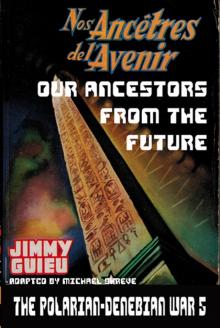 Polarian-Denebian War 5: Our Ancestors From the Future
Polarian-Denebian War 5: Our Ancestors From the Future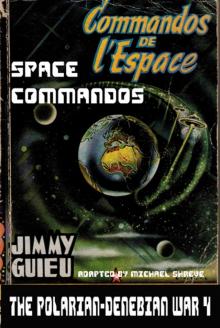 Polarian-Denebian War 4: Space Commandos
Polarian-Denebian War 4: Space Commandos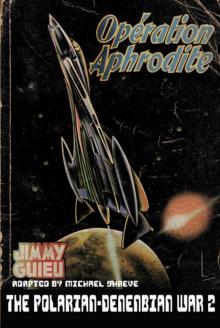 Polarian-Denebian War 2: Operation Aphrodite
Polarian-Denebian War 2: Operation Aphrodite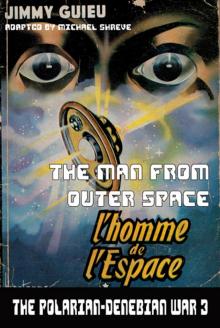 Polarian-Denebian War 3: The Man From Outer Space
Polarian-Denebian War 3: The Man From Outer Space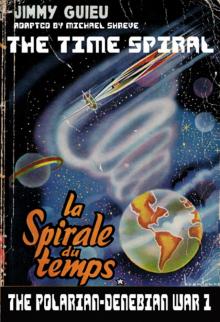 Polarian-Denebian War 1: The Time Spiral
Polarian-Denebian War 1: The Time Spiral